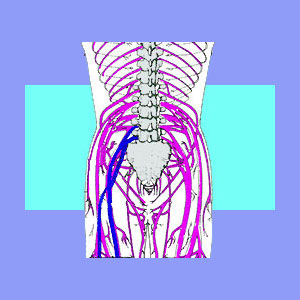
Nerve root impingement is a diagnostic conclusion often found on the MRI reports of back, neck and sciatica pain sufferers. Other typical wordings used to describe similar or identical conditions include: nerve root encroachment, mass effect on the nerve root and touching the nerve root. A related, but usually more severe, diagnostic conclusion is nerve root compression, also known as a pinched nerve.
This essay will detail what exactly impingement on a spinal nerve root means, the symptoms it may create and the treatment options which may be most effective for bringing much needed relief.
What is Nerve Root Impingement?
The spinal nerve roots are the bilateral branches of the neurological tissues which branch off the spinal cord at each vertebral level. There are ventral and dorsal nerve roots for each side, left and right. These nerves exit the spinal column through the neuroforamen, also called the foraminal spaces.
The word impingement means that something is in close proximity to or is contacting the nerve as it leaves the foraminal space. This word is used speculatively in many cases and is misused in others in which nerve root compression is obviously occurring.
When it comes to possible pinched nerves, impingement can be a very speculative word. This is why it is always crucial to discuss the exact wording found on your imaging or diagnostic reports with the doctors annotating the conclusion. It is absolutely vital to understand the exact extent of possible contact and the effects produced before taking any action towards treatment.
Causes of Nerve Root Compression
Nerve impingement in the spine can be caused by a wide range of structural sources, including any or all of the following:
Herniated discs can encroach on a nerve root, possibly enacting symptoms.
Osteoarthritic bone spurs can narrow the foraminal space and impinge on a nerve root.
Abnormal spinal curvatures, like scoliosis, lordosis or kyphosis, can have drastic effects on sensitive nerve roots.
Vertebral misalignment issues, such as spondylolisthesis, anterolisthesis or retrolisthesis can impinge on nerve roots.
General spinal degeneration, such as disc desiccation and arthritic changes, can impinge on nerve roots in rare instances.
Regardless of the theorized cause of impingement, it is important to be sure that the nerve is actually affected by the offending structure. Remember, many cases of diagnosed impingement do not produce any symptoms, leading the patient to seek treatment for an incorrectly identified source of pain. Your neurologist will prove to be your best ally when it comes to determining the effects, if any, that are being imparted to the spinal nerves by any structural impingement.
Nerve Root Impingement and Sciatica
Pinched nerves are one of the most commonly diagnosed theories of pain in the dorsalgia sector, which is ironic, considering they are actually quite rare. Most speculative pinched nerves do not adequately explain the symptomatic profile and some are completely and obviously unrelated, yet they take the blame anyway. This helps to explain why treatment for pinched nerves fails in far more cases than it succeeds. After all, if the symptoms are not being sourced by the suspected compressed nerve, they will not go away, even if the nerve is released. This is merely common sense at play here.
Remember that in the case of spinal nerve roots, compression will have effects in highly specific locations of the body. If the symptoms do not correspond to the diagnosis, then pursuing treatment will most surely be a waste of time, energy and money. But, don’t worry, your doctor won’t complain. They get paid anyway, success or not.
If a nerve is truly suffering from verified compression from a structural source, then it may require active treatment. Some conditions can be successfully treated nonsurgically, using such modalities as spinal decompression. Others may require surgical interventions, but should resolve fully if treated properly and without complication.





